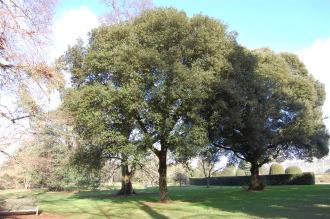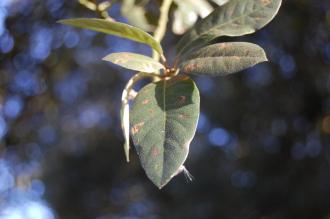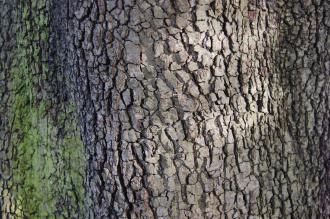
Quercus rotundifolia (08/02/2015, Kew Gardens, London)
Position: Full sun to partial shade
Soil: Free draining soil
Flowering period: Spring
Eventual Height: 25m
Eventual Spread: 20m
Hardiness: 7a, 7b, 8a, 8b, 9a, 9b, 10a, 10b
Family: Fagaceae
Quercus rotundifolia is a medium sized evergreen tree with a rounded habit. Its evergreen grey/ green leaves are leathery, whitish on the underside, elliptic with entire margins (spiny when young), up to 6cm long and 3cm wide. Its bark is black and finely cracked. Its male flowers are yellow catkin. Its fruit are acorns which are up to 35mm long.

Quercus rotundifolia Leaf (08/02/2015, Kew Gardens, London)
Quercus rotundifolia, commonly known as Holm Oak or Holly Oak, is native to the south west Mediterranean region including Spain, Portugal and Morocco. Quercus rotundifolia is synonymous with Quercus ilex subsp. rotundifolia and Quercus ilex ballota.
The etymological root of the binomial name Quercus is the ancient Latin name for an oak tree but some authorities believe it to be derived from the Celtic quer meaning ‘fine’ and cuez meaning ‘a tree’. Rotundifolia is derived from the Latin rotundus meaning ‘circular’ and folium meaning ‘leaf’.
The Landscape architect may find Quercus rotundifolia useful as an evergreen specimen tree which is tolerant of pollution. Once established this tree is drought tollerant.

Quercus rotundifolia Bark (08/02/2015, Kew Gardens, London)
Ecologically, Quercus rotundifolia is valuable to birds to provide shelter and nesting sites. The acorns also provide a source of food for birds and mammals.
Quercus rotundifolia prefers moist, fertile, well-drained soils. It tolerates most pH of soil.
Quercus rotundifolia requires little maintenance. Pruning should be carried out in late autumn to winter.

